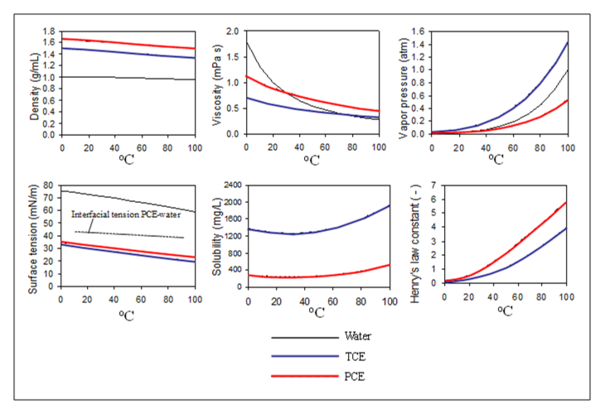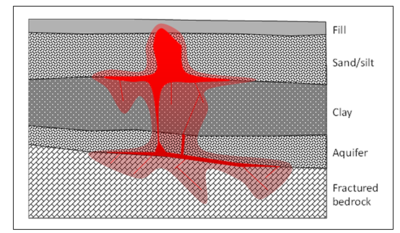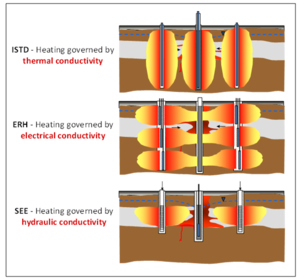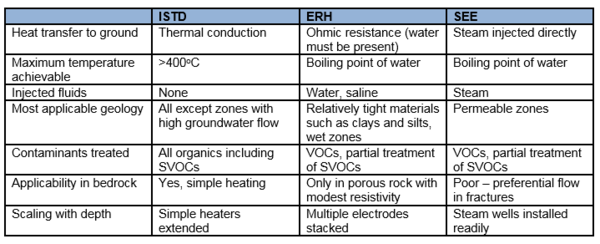Thermal Remediation
In situ thermal remediation (ISTR) has gained wide acceptance over the last 20 years. It is now considered an accepted contaminant source reduction technology with a high degree of certainty for achieving remedial objectives. ISTR consists of heating subsurface groundwater and the vadose zone to facilitate volatilization or other contaminant removal mechanisms, followed by contaminant extraction and treatment. The three major ISTR technologies are Thermal Remediation - Steam, Thermal Remediation - Electrical Resistance Heating and Thermal Remediation - Desorption. Technology selection depends on specific site conditions, contaminant properties, and remedial objectives. At many sites, thermal technologies can be combined with less aggressive remediation methods for complete site and plume restoration (e.g., see Thermal Remediation - Combined Remedies).
Related Article(s):
- Thermal Remediation - Steam
- Thermal Remediation - Electrical Resistance Heating
- Thermal Remediation - Desorption
- Thermal Remediation - Combined Remedies
- Thermal Remediation - Smoldering
CONTRIBUTOR(S): Dr. Gorm Heron
Key Resource(s): How Heat Can Accelerate In-situ Soil and Aquifer Remediation: Important Chemical Properties and Guidance on Choosing the Appropriate Technique[1]
Introduction
ISTR is typically used for source zones where conventional and less costly methods such as in situ chemical oxidation and enhanced bioremediation are not effective[2][3][1]. For example, ISTR might be applied to a contaminated site where non-aqueous phase liquid (NAPL) has migrated to significant depth and constitutes a source zone (Fig. 1).
Most in situ thermal technologies were originally developed and applied in the oil fields to enhance oil recovery. The most widely-used technologies are listed below (Fig. 2):
- Thermal Remediation - Steam. Steam is generated at the surface and injected into wells, sweeping to extraction wells for liquid and vapor removal[4].
- Thermal Remediation - Electrical Resistance Heating. Electrodes deliver electricity and water to the subsurface, and heating occurs in the subsurface. Vapors are typically extracted either from the electrodes or from separate extraction wells[5].
- Thermal Remediation - Desorption. ISTD is also called Thermal Conduction Heating, combined with fluid extraction. Simple heater borings transfer heat (no fluids) to the subsurface, and chemicals are extracted from liquid and vapor extraction wells[6].
Other less commonly used ISTR technologies are hot water injection, radio-frequency heating, and micro-wave heating. For sites with very high concentrations of hydrocarbons, smoldering may be used to degrade the contamination in place.
Applications and Strengths
There are several major applications and strengths of each of the three main ISTR technologies (Table 1). The major difference between the technologies is that ISTD can be used to heat dry soils and to treat semi-volatile organic compounds (SVOCs), whereas ERH and SEE is limited by the presence of water, and therefore can be used to reach the boiling point. This limits these technologies for targeting volatile organic compounds (VOCs) and to partially treat SVOCs, since temperatures are not high enough to volatilize and completely remove chemicals such as dioxins or polychlorinated biphenyls (PCBs).
In general terms, ERH has been used primarily for relatively shallow VOC source zones, where achievement of the boiling point of water is sufficient to remediate volatile contaminants. SEE is used in permeable formations and can overcome cooling by groundwater flow. ISTD is used in the same settings as ERH, plus at sites where more aggressive treatment is needed, for instance to reach a lower concentration target, or to treat less volatile contaminants of concern (COCs). ISTD and SEE are readily combined for complex sites with both low permeability zones and significant groundwater flow.
Mechanisms – How are Contaminants of Concern (COCs) Removed?
For volatile contaminants like chlorinated solvents, vaporization is the dominant mechanism for remediation. The vapor pressure and Henry's Law constant for trichloroethylene (TCE) and perchloroethylene (PCE) increase with temperature, leading to chemical vaporization once heated (Fig. 3).

For oils, tars, creosote and semi-volatile chemicals, viscosity reduction and recovery may also be an important mechanism. These fluids are removed by multi-phase extraction. The heating can be done with any of the three major ISTR methods. For complete removal of these less volatile chemicals, the subsurface needs to be heated to temperatures above the boiling point of water (typically between 200 and 335oC). This can only be accomplished using ISTD[6].
Contaminant Extraction and Treatment
Since ISTR involves making chemicals mobile either in liquid or vapor form, extraction and capture is essential. A site-specific analysis must be used to determine the strategy for extraction. Hydraulic control is maintained either by the use of barriers, or more often by extracting more fluids than used for heating and injection. Inward gradients must be maintained and demonstrated during the heating period. Pneumatic control is maintained by using tight vapor covers and by extracting sufficient quantities of air and steam to create a vacuum in the unsaturated part of the treatment zone.
Extracted liquids and vapors are typically cooled, separated, and treated using standard liquid and vapor treatment methods such as gravity separation, charcoal filtration, thermal oxidation, and filtering.
Monitoring During ISTR
During thermal operation, monitoring and sampling efforts are used to document progress[8] as follows:
- An energy balance is maintained and compared to modeled energy delivery and heating.
- Subsurface temperatures are documented using thermocouples or similar devices, providing near real-time documentation of the heating process.
- Mass removal rates and totals are tracked for vapor and liquid streams.
- Hydraulic and pneumatic control is documented by a combination of well-field gradient measurements and mass balance calculations.
Before completion of ISTR, confirmatory sampling of soil and groundwater is performed to document that the remedial goals have been met. Tested methods for hot sampling exist[9].
Summary
At many sites, in situ thermal technologies have provided an answer to a major challenge: How to treat heavily contaminated source zones to low standards? The three dominant methods (SEE, ERH, ISTD) have now been used at >200 sites. When site conditions are well understood, and the thermal system properly implemented, results have been very positive (i.e., remediation goals have been achieved). These technologies have matured so that they are no longer innovative and results are predictable.
References
- ^ 1.0 1.1 Davis, E.L., 1997. How heat can accelerate in-situ soil and aquifer remediation: important chemical properties and guidance on choosing the appropriate technique. US EPA Issue Paper. Report pdf
- ^ Hunt, J.R., Sitar, N. and Udell, K.S., 1988. Nonaqueous phase liquid transport and cleanup: 1. Analysis of mechanisms. Water Resources Research, 24(8), 1247-1258. doi: 10.1029/WR024i008p01247
- ^ Udell, K.S., 1996. Heat and mass transfer in clean-up of underground toxic wastes. In annual reviews of heat transfer, Vol. 7, Chang-Lin Tien, Ed.; Begell House, Inc.: New York, Wallingford, UK, pgs. 333-405. doi: 10.1615/AnnualRevHeatTransfer.v7.80
- ^ Udell, K.S., Sitar, N., Hunt, J.R. and Stewart Jr, L.D., 1991. Process for in situ decontamination of subsurface soil and groundwater. The Regents of The University of California, U.S. Patent 5,018,576.
- ^ Gauglitz, P.; Roberts, J.; Bergman, T.; Schalla, R.; Caley, S.; Schlender, M.; Heath, W.; Jarosch, T.; Miller, M.; Eddy-Dilek, C.; Moss, R.; Looney, B., 1994. Six-phase soil heating for enhanced removal of contaminants: Volatile organic compounds in non-arid soils. Integrated demonstration, Savannah River Site. Report No. PNL-10184, UC-406. Pacific Northwest Laboratory, California, USA. doi: 10.2172/10193982
- ^ 6.0 6.1 Stegemeier, G.L. and Vinegar, H.J., 2001. Thermal conduction heating for in-situ thermal desorption of soils. Chapter, 4, 1-37. In Chang H. Oh (ed.), Hazardous and Radioactive Waste Treatment Technol. Handbook, CRC Press, Boca Raton, FL. ISBN 9780849395864
- ^ Heron, G., Baker, R.S., Bierschenk, J.M. and LaChance, J.C., 2006. Heat it All the Way-Mechanisms and Results Achieved using In-Situ Thermal Remediation. In Paper F-13, in: Bruce M. Sass (Conference Chair), Remediation of Chlorinated and Recalcitrant Compounds. Proceedings of the Fifth International Conference on Remediation of Chlorinated and Recalcitrant Compounds, Monterey, CA. ISBN 1-57477-157-4
- ^ Newmark, R.L. (ed.) 1994. Demonstration of Dynamic Underground Stripping at the Lawrence Livermore National Laboratory Gasoline Spill Site. Final Report UCRL-ID-116964, Vol. 1-4. Lawrence Livermore National Laboratory, Livermore, California.
- ^ Gaberell, M., Gavaskar, A., Drescher, E., Sminchak, J., Cumming, L., Yoon, W.S. and De Silva, S., 2002. Soil core characterization strategy at DNAPL sites subjected to strong thermal or chemical remediation, In: A.R. Gavaskar and A.S.C. Chen (Eds.). Remediation of Chlorinated and Recalcitrant Compounds. Proceedings of the Third International Conference on Remediation of Chlorinated and Recalcitrant Compounds (Monterey, CA). Battelle Press, Columbus, OH. ISBN 1-57477-132-9. doi: 10.1016/j.jhazmat.2003.09.006
See Also
- Investigation of Chemical Reactivity, Mass Recovery and Biological Activity During Thermal Treatment of DNAPL Source Zones
- Large-Scale Physical Models of Thermal Remediation of DNAPL Source Zones in Aquifers
- Thermal Remediation of DNAPL Source Zones
- Contaminant Mass Transfer During Boiling in Fractured Geologic Media
- Critical Evaluation of State-of-the-Art In Situ Thermal Treatment Technologies for DNAPL Source Zone Treatment
- DNAPL Removal from Fractured Rock Using Thermal Conductive Heating
- Combining Low-Energy Electrical Resistance Heating with Biotic and Abiotic Reactions for Treatment of Chlorinated Solvent DNAPL Source Areas


